|
Thalassarche carteri (Indian
yellow-nosed albatross)
Indiese geelneusalbatros [Afrikaans]; Indiese
geelneusmalmok [Afrikaans]; Albatros de l’océan indien [French]
Life
> Eukaryotes >
Opisthokonta
> Metazoa (animals) >
Bilateria >
Deuterostomia > Chordata >
Craniata > Vertebrata (vertebrates) > Gnathostomata (jawed
vertebrates) > Teleostomi (teleost fish) > Osteichthyes (bony fish) > Class:
Sarcopterygii (lobe-finned
fish) > Stegocephalia (terrestrial
vertebrates) > Tetrapoda
(four-legged vertebrates) > Reptiliomorpha > Amniota >
Reptilia (reptiles) >
Romeriida > Diapsida > Archosauromorpha > Archosauria >
Dinosauria
(dinosaurs) > Saurischia > Theropoda (bipedal predatory dinosaurs) >
Coelurosauria > Maniraptora > Aves
(birds) > Order: Ciconiiformes
> Family: Diomedeidae
 |
|
Indian yellow-nosed albatross, offshore from Cape
Town, South Africa. [photo Trevor Hardaker ©] |
 |
|
Indian yellow-nosed albatross, offshore from Cape
Town, South Africa. [photo Trevor Hardaker ©] |
Distribution and habitat
Breeds on islands in the south-west Indian Ocean,
dispersing across the South Indian Ocean in the non-breeding season, mainly
between 25-50° South. It is common off the southern and eastern coasts of South
Africa, while more scarce off the northern Cape and southern Mozambique.
Predators and parasites
- Parasites at breeding colonies
- Pasturella multicida (avian cholera)
- Erysipelothrix rhusiopathidae (bacterium)
Movements and migrations
Present year-round off the south coast,
although it is most common in the period from June-September, as
most birds return to their breeding colonies in August.
Food
It mainly eats fish, supplemented with crustaceans, squid
and offal from fishing vessels. It does most of its foraging by catching prey on
the water surface, or occasionally diving to greater depths, The following food items have been recorded
in its diet:
- fish
- Scomberesox saurus (Saury)
- Etrumeus whiteheadi (Round herring)
- Engraulis encrasicolus (Anchovy)
- Sardinops sagax (Sardine)
- Trachurus trachurus (Horse mackerel)
- Lampanyctodes hectoris (lanternfish)
- pelagic crustaceans
- squid
- fishery bycatch and offal
Threats
Although previously classified as Vulnerable, it is
now considered Endangered due to a continually decreasing population at
its main breeding colony at Amsterdam Island; the population has decreased there
by 50% from 1980-2000. This is thought to have been largely caused by parasite
infestations in chicks and adults, and it is also seriously affected by
mortalities on longlines. Thankfully its breeding colony on Prince Edward Island
is still stable.
References
-
Hockey PAR, Dean WRJ and Ryan PG 2005. Roberts
- Birds of southern Africa, VIIth ed. The Trustees of the John Voelcker
Bird Book Fund, Cape Town.
|
